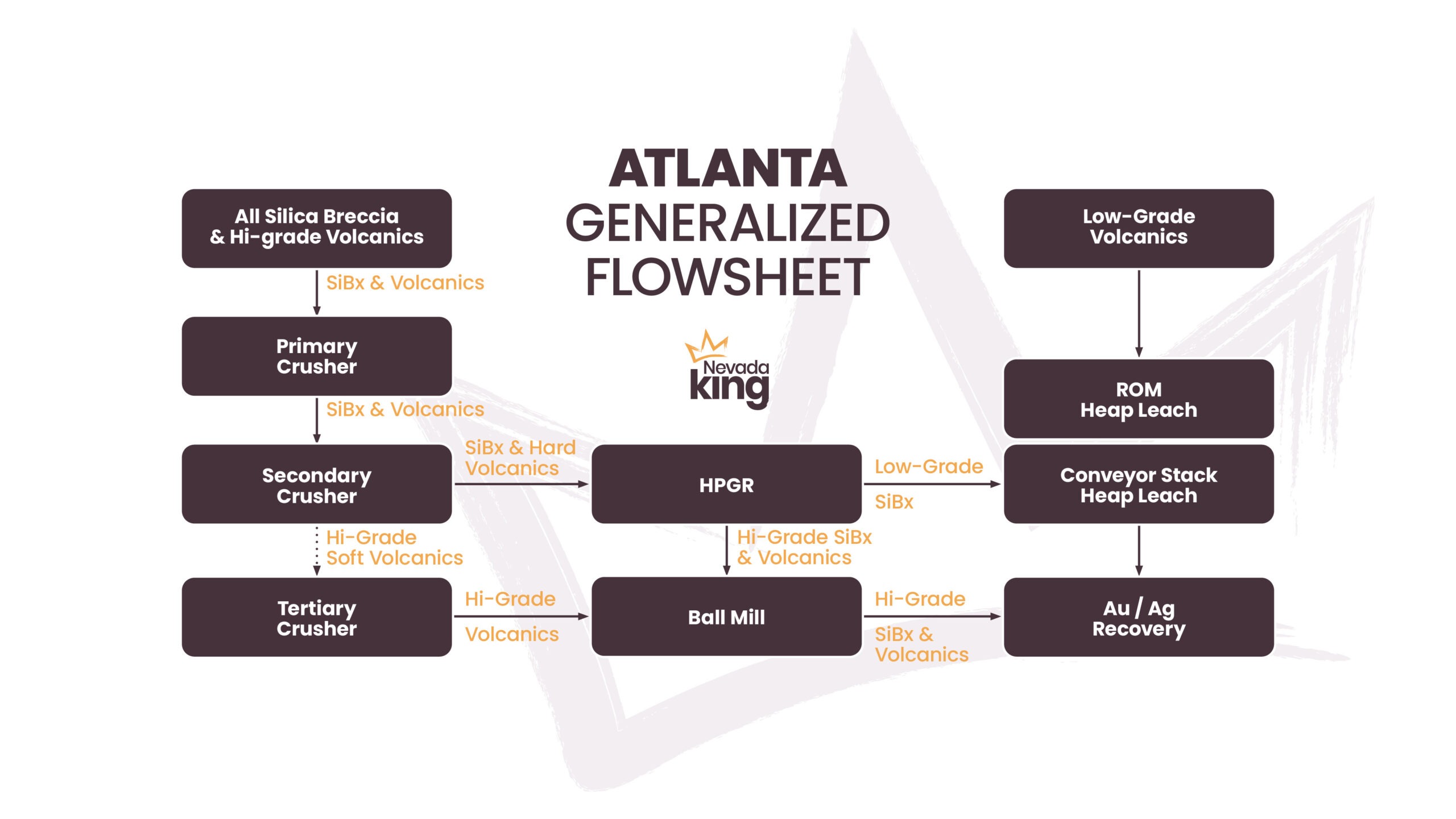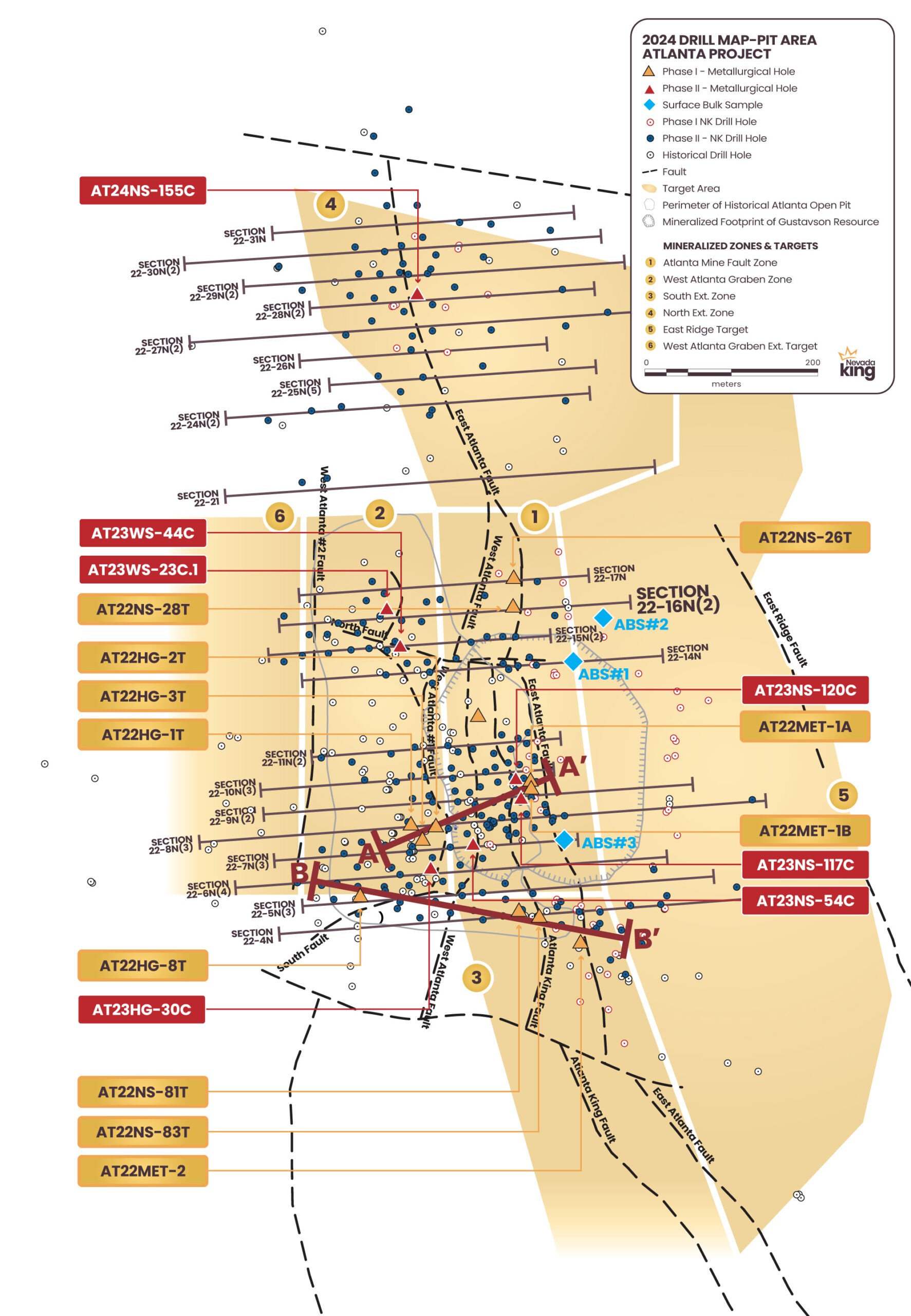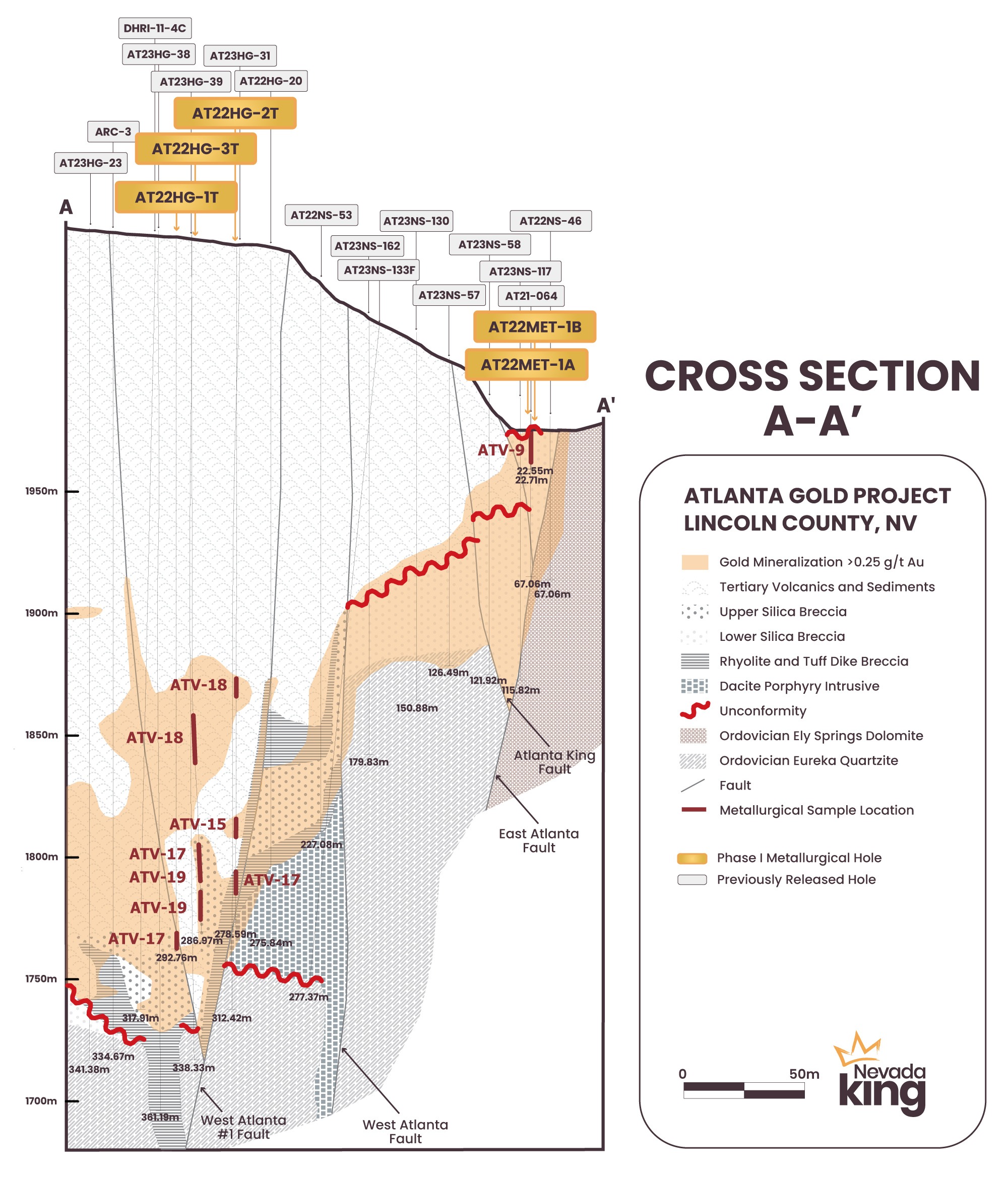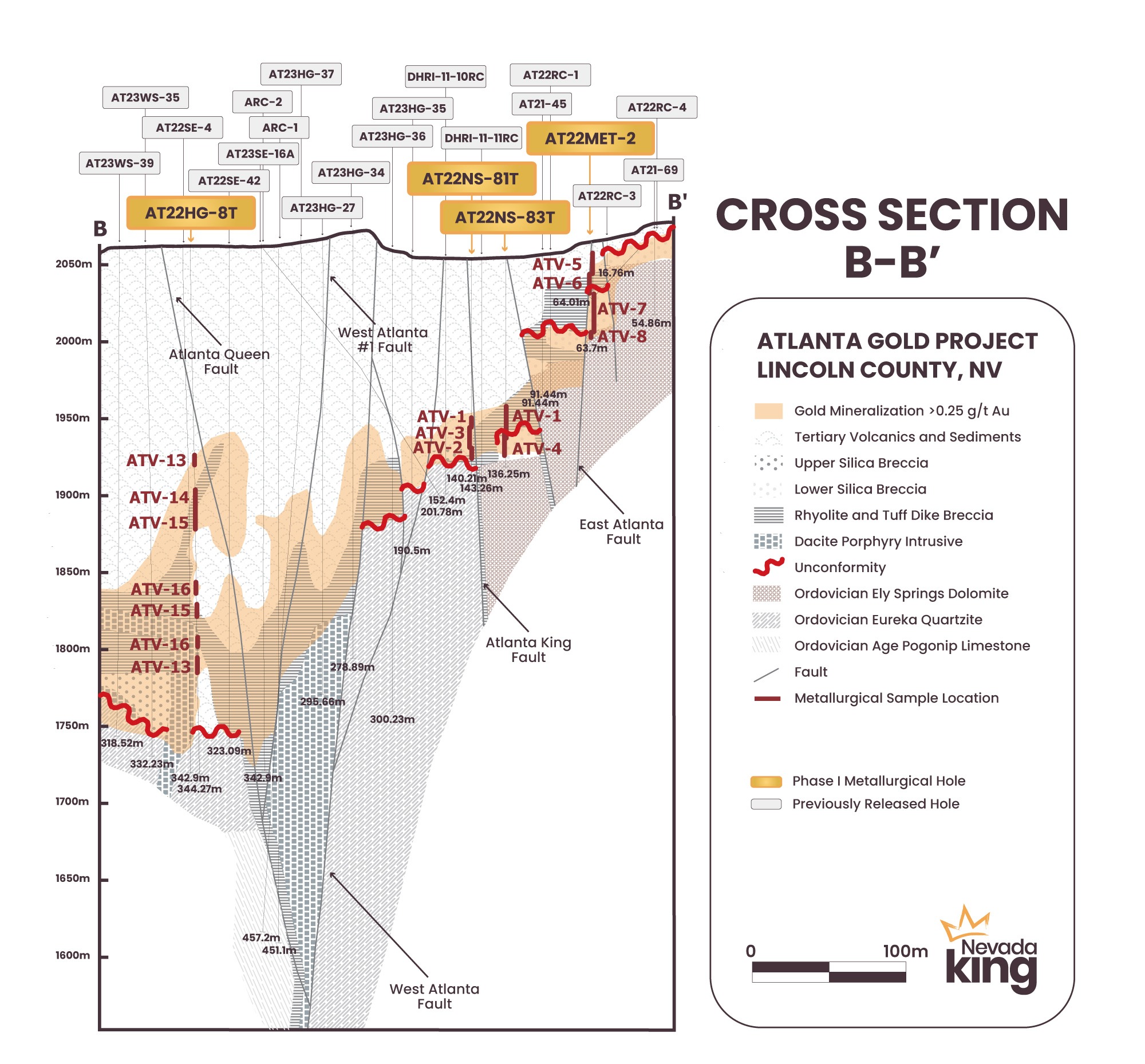VANCOUVER, BC, March 26, 2024 – Nevada King Gold Corp. (TSXV: NKG; OTCQX: NKGFF) (“Nevada King” or the “Company“) is pleased to report results from an extensive Phase I metallurgical testing program at the Atlanta Gold Mine Project, located in the prolific Battle Mountain Trend, 264km northeast of Las Vegas, Nevada. The objective of the Phase I program was to test the various mineralized host rocks at Atlanta for gold and silver extraction, using conventional flowsheet unit operations to guide in selecting a process flowsheet suitable for the commercial extraction of gold and silver from the project. Results of the Phase I test work support strong recoveries utilizing conventional Nevada oxide processing methods for the representative mineralization types present at Atlanta.
- Phase I testing used three surface bulk samples and 19 composites from drill core comprising the full range of rock types and gold and silver grades encountered across Atlanta. Mineralization at Atlanta can be broadly characterized by two major host domains: 1) Silicified breccias found within and below the main Atlanta unconformity, and 2) Volcanics found above the main Atlanta unconformity (refer to cross sections A-A and B-B in Figures 3-4 below).
- Results of Phase I support conventional Nevada oxide processing methods for Atlanta whereby:
- Silicified breccias are amenable to conventional milling for high-grade material and High-Pressure Grinding Roll (“HPGR“) crushing and heap leaching for the lower-grade material.
- Volcanics are amenable to conventional milling for high-grade material and Conventional Crush or Run-of-Mine (“ROM“) heap leaching for the lower-grade material.
- Silicified breccias are amenable to conventional milling for high-grade material and High-Pressure Grinding Roll (“HPGR“) crushing and heap leaching for the lower-grade material.
- Applicable to process plant scenarios, gold extraction from fine milling at a 200-mesh grind (P80=75µm) show a weighted average extraction of 91.7% for gold hosted in volcanics and 85.9% for the high-grade silica breccias.
- Silver extraction from fine milling at a 200-mesh grind (P80=75µm) show a weighted average 65.3% in the volcanics and 41.3% in the silica breccias. At coarser crush size silver extractions are similar between the two metallurgical domains.
- Applicable to heap leach scenarios, gold extraction from conventional crushing (P80=12.5 mm) shows a weighted average extraction of 87.1% for gold hosted in volcanics. Gold extraction from HPGR crushed composites (using medium press force) shows a weighted average 71.4% extraction from low-grade silica breccias.
- A Phase 2 metallurgical PQ core drilling program has now been completed to fill some gaps in the target resource envelope and further laboratory testing utilizing material from this drilling is scheduled to start later in 2024. The location of these holes can be found in the drill hole plan map below in Figure 2.
Bulk Sample and Phase 1 metallurgical test work at Atlanta has been supervised by Gary Simmons (MMSA QP Number: 01013QP), formerly the Director of Metallurgy and Technology for Newmont Mining Corp. Mr. Simmons has supervised and managed numerous Carlin-style metallurgical testing programs in the Great Basin with characteristics similar to those found at Atlanta.
Mr. Simmons commented, “Historic production at Atlanta focused on near-surface high-grade silica breccia ores that were processed and recovered using conventional oxide milling practices. Historical records (1979-85) indicate recoveries from the silica breccias necessitated a fine-grind milling and Merrill-Crowe recovery process that averaged 81% for gold and 42% for silver at ball mill grind P80 = 120µm (microns). This historical milling operation was challenged by the hard and abrasive nature of the silica breccias, resulting in elevated-maintenance and operating costs in primary, secondary, and tertiary crushing circuits.
“Today’s results confirm that conventional oxide milling, and HPGR crush heap-leach or ROM heap-leach, depending on mineralization type, are well suited for processing gold and silver mineralization at Atlanta. Referring to a conceptual Atlanta generalized flowsheet in Figure 1 below, a straightforward process breaks out the host mineralization into their respective silica breccia and volcanic units, running high-grade mineralization through a mill and processing lower grade material via a combination HPGR crush and ROM heap leaching. The adoption of HPGR crushing technology (used at other mines in Nevada and around the world) will eliminate SAG milling of silica breccias and high-grade volcanics that in turn should result in reduced overall operating cost against a conventional SABC (Semi-Autogenous-Ball Mill-Crusher) circuit design. It is anticipated that this process will be more cost-effective than historical methods, resulting in lower process cutoff grades and potential for economic extraction of gold and silver from a larger volume of material.”
Collin Kettell, Founder & CEO of Nevada King, stated, “Positive results from the Phase 1 metallurgical test work released today indicate a clear path forward for processing Atlanta’s gold and silver mineralization via a combination of crushed and run-of-mine heap leaching together with conventional milling of high-grade mineralization. In a major departure from historical processing and test-work at Atlanta, the potential for using HPGR crushing, as indicated by Phase 1 enhanced test recoveries, could result in very significant benefits and opportunities for flow sheet development in a future potential mining operation. Test results also indicate significantly higher Au/Ag recoveries in the volcanic section, which is fast becoming a major component of the overall mineralized footprint at Atlanta. Looking forward, ongoing resource modeling and metallurgical studies will focus on optimizing the potential economics of mining and processing scenarios utilizing the alternative process options for which this Phase 1 testing program has indicated positive extraction results.”
Test Results Summary:
Atlanta mineralized resources have been characterized into two major resource categories for gold and silver processing: 1. Silicified breccias (mineralized material in and below the main Atlanta unconformity) and Volcanics (mineralized material above the main Atlanta unconformity).
A breakout of the materials tested above and below the Atlanta unconformity and the laboratory metallurgy gold extraction test results are summarized in Table 1. A full range of rock types at Atlanta have been tested and test results clearly show the significant metallurgical difference between the silicified breccias and the volcanics. A similar table summarizing silver extractions for Atlanta can be found in Table 2.
Silicified breccias, below the unconformity, are hard and abrasive rocks and have a high degree of sensitivity to process feed particle size.
- Victory Metals, Inc. (Nevada King Gold Corp.) NI 43-101 Technical Report on the Atlanta Project dated December 22, 2020, reported historic Atlanta mill recoveries, for the years 1979-85 at 81% for Au and 42% for Ag, at operating ball mill grind P80 = 120µm (microns).
- Silicified breccias are amenable to High Pressure Grinding Roll (HPGR) comminution, where high-grade would report to a mill and lower-grade to heap leaching. The determination between higher-grade and lower-grade material will be dependent upon future economic analysis.
- Of significant note is that as the silica breccia gold grade decreases (<1.7 ppm Au), gold extraction increases at coarser P80 particle size, as shown in Table 1. Thus, reinforcing the benefit of milling higher grade and HPGR crush-heap leaching of the lower grade resources.
- Volcanics, above the unconformity, are relatively insensitive to process feed particle size and can be characterized as equal or similar to central Nevada commercial heap leach operations.
- Volcanics are amenable to conventional milling, conventional crush heap leaching and/or ROM heap leaching.
Gold extraction from fine milling at a 200 mesh grind (P80=75µm) show a weighted average:
- 91.7% extraction in the volcanics
- 87.5 % extraction in the low-grade silica breccias
- 85.9% extraction in the high-grade silica breccias
Gold extraction from conventional crushing (P80=12.5 mm) show a weighted average:
- 87.1% extraction from volcanics
- 62.1% extraction from low-grade silica breccias
- 37.0% extraction from high grade silica breccias
Gold extraction from HPGR crushed composites show a weighted average:
- 81.9% extraction from volcanics (only four of the nine volcanic composites were tested using HPGR as the remaining five composites contained elevated levels fines and are not suitable for HPGR processing)
- 71.4% extraction from low-grade silica breccias (<1.7 ppm Au)
- 50.4% extraction from high-grade silica breccias
QA/QC Protocols
All PQ-diameter core for the Phase 1 testing program was ¼ cut with a diamond saw, with the ¼ sample being sent to American Assay Lab in Reno, Nevada, while the ¾ samples were sent to Kappes and Cassiday Associates, also in Reno. Samples were cut under the Company’s supervision in its Winnemucca, Nevada, warehouse and all samples were placed in heavy canvas bags. CRF standards and coarse blanks were inserted into the sample stream on a one-in-twenty sample basis, meaning both inserts are included in each 20-sample group. Samples were shipped by a local contractor in large sample shipping crates directly to American Assay Lab in Reno, Nevada, with full custody being maintained at all times. At American Assay Lab, samples were weighted then crushed to 75% passing 2mm and pulverized to 85% passing 75 microns in order to produce a 300g pulverized split. Prepared samples are initially run using a four acid + boric acid digestion process and conventional mutli-element ICP-OES analysis. Gold assays are initially run using 30-gram samples by lead fire assay with an OES finish to a 0.003 ppm detection limit, with samples greater than 10 ppm finished gravimetrically. Every sample is also run through a cyanide leach for gold with an ICP-OES finish. The QA/QC procedure involves regular submission of Certified Analytical Standards and property-specific duplicates.
Qualified Person
The geological information in this news release has been reviewed and approved by Calvin R. Herron, P.Geo., who is a Qualified Person as defined by National Instrument 43-101 (“NI 43-101“). Mr. Herron is not independent for purposes of NI 43-101 as he is Exploration Manager of Nevada King.
About Nevada King Gold Corp.
Nevada King is the third largest mineral claim holder in the State of Nevada, behind Nevada Gold Mines (Barrick/Newmont) and Kinross Gold. Starting in 2016 the Company has staked large project areas hosting significant historical exploration work along the Battle Mountain trend located close to current or former producing gold mines. These project areas were initially targeted based on their potential for hosting multi-million ounce gold deposits and were subsequently staked following a detailed geological evaluation. District-scale projects in Nevada King’s portfolio include (1) the 100% owned Atlanta Mine, located 100km southeast of Ely, (2) the Lewis and Horse Mountain-Mill Creek projects, both located between Nevada Gold Mines’ large Phoenix and Pipeline mines, and (3) the Iron Point project, located 35km east of Winnemucca, Nevada.
The Atlanta Mine is a historical gold-silver producer with a NI 43-101 compliant pit-constrained resource of 460,000 oz Au in the measured and indicated category (11.0M tonnes at 1.3 g/t) plus an inferred resource of 142,000 oz Au (5.3M tonnes at 0.83 g/t). See the NI 43-101 Technical Report on Resources titled “Atlanta Property, Lincoln County, NV” with an effective date of October 6, 2020, and a report date of December 22, 2020, as prepared by Gustavson Associates and filed under the Company’s profile on SEDAR+ (www.sedarplus.com).
Please see the Company’s website at www.nevadaking.ca.
Neither the TSX Venture Exchange nor its Regulation Services Provider (as that term is defined in the policies of the TSX Venture Exchange) accepts responsibility for the adequacy or accuracy of this release.
Cautionary Statements Regarding Forward Looking Information
This news release contains certain “forward-looking information” and “forward-looking statements” (collectively “forward-looking statements”) within the meaning of applicable securities legislation. All statements, other than statements of historical fact, included herein, without limitation, statements relating the future operations and activities of Nevada King, are forward-looking statements. Forward-looking statements are frequently, but not always, identified by words such as “expects”, “anticipates”, “believes”, “intends”, “estimates”, “potential”, “possible”, and similar expressions, or statements that events, conditions, or results “will”, “may”, “could”, or “should” occur or be achieved. Forward-looking statements in this news release relate to, among other things, statements regarding extraction results from the Phase I program and the effect thereof, laboratory testing of material from the Company’s Phase 2 metallurgical PQ core drilling program, and the effect of extraction results thereof. There can be no assurance that such statements will prove to be accurate, and actual results and future events could differ materially from those anticipated in such statements. Forward-looking statements reflect the beliefs, opinions and projections on the date the statements are made and are based upon a number of assumptions and estimates that, while considered reasonable by Nevada King, are inherently subject to significant business, economic, competitive, political and social uncertainties and contingencies. Many factors, both known and unknown, could cause actual results, performance or achievements to be materially different from the results, performance or achievements that are or may be expressed or implied by such forward-looking statements and the parties have made assumptions and estimates based on or related to many of these factors. Such factors include, without limitation, the ability to complete proposed exploration work, the results of exploration, continued availability of capital, and changes in general economic, market and business conditions. Readers should not place undue reliance on the forward-looking statements and information contained in this news release concerning these items. There is no certainty, and the Company cannot provide assurance, that the results of the Phase I program will be realized in part or at all. The findings will require further assessment and analysis, including additional met core variability testing, comminution and environmental characterization and design engineering studies. Nevada King does not assume any obligation to update the forward-looking statements of beliefs, opinions, projections, or other factors, should they change, except as required by applicable securities laws.







